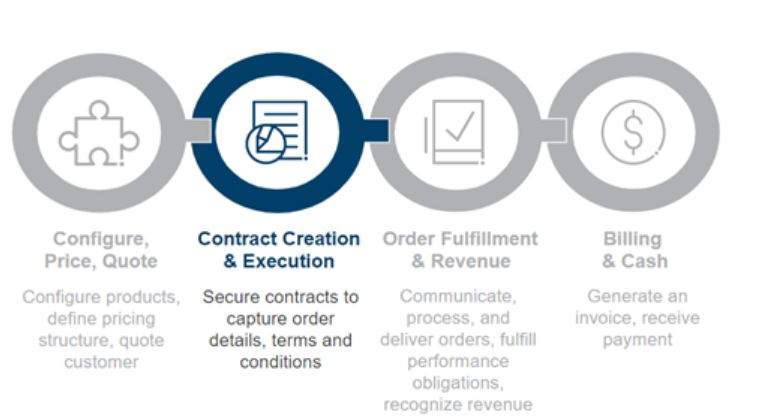In Protiviti’s recent post, Easy As CPQ: Launching A Successful Sales Cycle, we outlined the Configure, Price Quote phase of the Q2C process. The next critical step in a company’s quote-to-cash (Q2C) process, and one that helps solidify accurate revenue collection, reporting and a good customer experience, is contract creation and execution. During this phase, any prior negotiations are solidified in a legally binding contract that details the order that will be delivered to the customer. This blog sheds light on the key steps of contracting, and factors organizations should consider to avoid common issues.

Quote-to-cash process
The nuts and bolts
Contracts come into play after striking a deal. Once a quote has been agreed to and approved by all parties, it is typically converted to an order request, which serves as the initial form of the contract. For the purposes of this blog, we will focus on sales and service contracts.
The sales contract should spell out – in as much detail as possible – the obligations, rights and consequences for breaking the contract for both the seller and buyer. The order request becomes the basis for the bill of sale, which is a simpler document that defines the transfer of ownership of the goods from one party to the other. The contract additionally includes all the “fine print” that can vary between each order, such as the timeline to provide the product, legal terms about what happens if the product is not delivered within the defined timeline, payment types and terms, key assumptions, any product warranty and other key details. Some of the standard fine print can include data privacy terms, confidentiality clauses and disclosure statements.
A service contract includes much of the same contract terms, with the key difference being it outlines a service to be delivered instead of a tangible good, so the delivery terms defined may get more complicated.
Generally, the process will begin with the sales team creating and accepting the quote, then moving the quoted sale or service to the team responsible for adding the required contractual elements previously mentioned, and then to the individuals and buyers responsible for formally signing and locking in the contract. Teams can expect more negotiations the first time a contract is created with a new buyer, including terms and conditions not specified in the quote. Where there are existing relationships, the conversation can focus on critical elements such as timeline, deliverables and payment terms.
Essential considerations
Some of the essential considerations that should be factored in to help organizations create and manage effective contracts:
- Review business strategy: Before committing to a sales contract, functional teams should coordinate to ensure delivery on proposed terms can be achieved. Failing to deliver on commitments can trigger service level agreements and cost the organization business in the long run. Additionally, delivery constraints may force a choice between a loyal repeat customer or a significant one-time sale.
- Standardize language: Creating standardized templates help reduce the contracting timeline. Standardized templates, such as master service agreements (MSAs), contain terms the seller/service provider can utilize for initial and subsequent agreements. Accounting, finance, legal, sales, customer support and production should all weigh in during the contracting process, ideally when developing the standardized terms, or defining customized language when necessary.
- Define workflow: For the contractual elements requiring customized language, the business rules, the roles in the process and the routing paths should be defined as part of the contract governance process. Each of these pieces (rules, roles, and routing) can – and should – be maintained in the solution so the path is clear when it comes time to create a new contract.
- Manage long-term: The right solution should house the start and end dates of the contracts to facilitate ongoing contract management that should continue to take place after delivery of the good or service. Organizations will need to know if a product is still under warranty at a point in time or if privacy and data clauses are broken, and the terms agreed upon with the customer in these cases.
- Harness AI: Natural language processing (NLP) can help with drafting a contract by extracting risks from previous contracts and comparing clauses from a pre-set library to speed up the drafting and approval process. Intelligent workflow can reduce approval time.
Taking action of these considerations can help organizations move from an ad hoc or repeatable contracting process towards one that is optimized, incorporates automation, manages risk, and promotes continuous improvement. Incorporating these improvements will create a better experience for the business and for customers.
Measure success
Measuring success is an important piece of the Q2C process, and determining what success looks like and how to measure it within the contract creation and execution phase will enable a better overall process. However, many organizations don’t know where to start… so, what are the important KPIs?
Subscription and sales-based contracts should both focus on timelines and renewals to save money and retain customers. A typical KPI is the number of days it takes to have a fully signed contract after a quote is accepted. This includes setting standards for different divisions since it must pass through multiple hands before being ready for a buyer. While a seller cannot control the time a contract sits with a buyer, the time it is held internally can be controlled. Tracking missed milestones once a contract has commenced will allow for proactive client communication which can better the working relationship. Tracking when contracts deviate from the pre-approved language is also important to prevent risk of further delays. Another important area to note is the percentage of contracts that are not renewed, which can aid in identifying improvement areas for customer retention. Data and rules to support these success measures (timeline metrics, rules, roles, and routing, milestones for each stage) can be captured and monitored in the right contracting solution.
Preparing for the future
When thinking about the teams, process steps, and technologies involved, choosing, designing, and maintaining the right contract solution can be daunting. Protiviti is equipped with experts to help navigate the challenges of contracts, identify unique process requirements and position organizations to execute contracts in a timely manner. Addressing contracting concerns can facilitate an accurate revenue cycle for the organization and keep customers satisfied throughout the process. Contact us to learn more about our enterprise application consulting solutions.
Bob Kiddoo, Senior Director – Enterprise Application Solutions, also contributed to this post.






